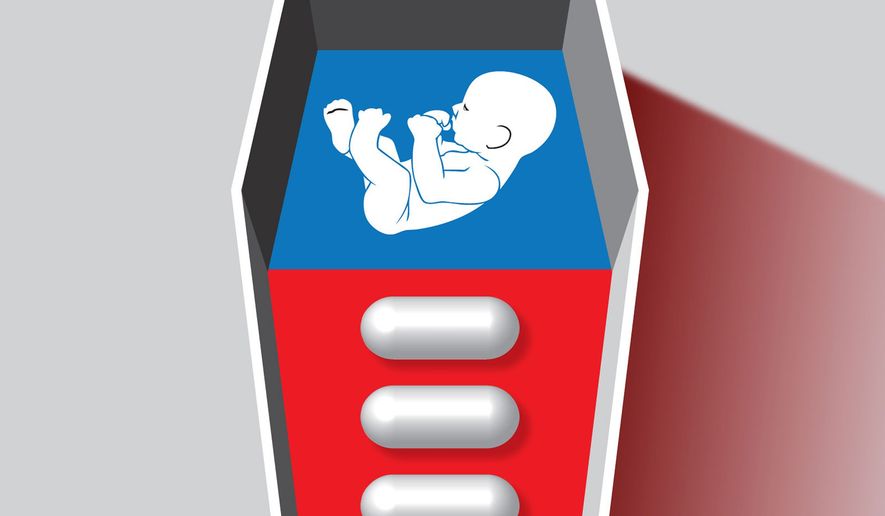OPINION:
As an obstetrician practicing in Texas, I have cared for many women hurt by abortion — although, like approximately 90% of my obstetric peers, I do not perform elective abortions. I advocate for the life and health of both of my patients: the woman and her unborn child.
In the wake of state laws protecting unborn life and reckless decisions by the Food and Drug Administration, abortion drugs have flooded my state, carried in by abortion advocates, obtained from out-of-state abortion providers, illegally delivered through the mail and transported over the U.S. border from Mexico.
The abortion drug regimen is made up of two drugs. Mifepristone blocks progesterone receptors, cutting off hormonal support and ending the unborn life, followed 24 to 48 hours later with misoprostol, which induces contractions to expel the baby and other pregnancy tissue.
Mifepristone was initially approved by the FDA in 2000, utilizing “accelerated approval regulations” intended to rapidly approve drugs used to treat life-threatening conditions. The FDA failed to study its use in a pediatric population despite laws requiring such studies.
In 2021, using the COVID-19 pandemic as an excuse, the FDA proceeded to remove requirements for in-person supervision of mifepristone, allowing abortion drugs through telemedicine, ordered online, or delivered through the mail.
In addition, in early 2023, approval was given for pharmacy distribution. Consequently, many women are obtaining abortion drugs without ever looking a physician in the eye, obtaining a physical exam or sonogram, or documenting bloodwork.
As the Supreme Court hears oral arguments in Alliance for Hippocratic Medicine v. Food and Drug Administration on Tuesday, which will in part address whether the FDA acted rightly in loosening regulations on abortion drugs, I recall the many harms I have seen in my practice.
One young woman bled daily for two months after obtaining these drugs because of retained dead pregnancy tissue in her uterus, which required surgical removal. Another was hospitalized for sepsis, a serious blood infection warned about in the FDA’s “black box warning” on mifepristone.
Other women have lost large amounts of blood quickly, requiring fluid resuscitation and occasionally a blood transfusion. Many are emotionally shaken. They have been reassured that abortion drugs are “safer than Tylenol or penicillin” and are surprised when they bleed heavily for an average of two weeks, experience severe pain like that suffered in labor, and often see the child — which is clearly identifiable as human — they have chosen to abort.
I expect to continue to see women with complications because of these inappropriate and cavalier decisions by the FDA. The FDA’s actions have and will continue to cause women’s crises to become much worse. Underestimation of gestational age because of failure to accurately date the pregnancy by ultrasound will lead to higher failure rates, often requiring emergency surgery.
Abortion drugs provided in the second trimester fail as often as 38% of the time. Failure to rule out ectopic pregnancy with ultrasound may lead to tubal ruptures, catastrophic internal bleeding and possibly maternal deaths. Finally, failure to verify that the person requesting abortion drugs truly wants an abortion will lead to misuse by sex traffickers, incestuous abusers and coercive fathers, causing unwanted abortions.
Inadequate and biased counseling further leads many women to choose abortion drugs under the assumption that they are safe and the only solution to an unexpected pregnancy, but this benefits the abortion industry, not the woman in need. The American Medical Association states that informed consent for medical treatment must include “the burdens, risks, and expected benefits of all options, including forgoing treatment.”
There’s also the question of whether women in unplanned pregnancies are giving truly informed consent. When a woman orders abortion drugs from an abortion website, is she informed that almost 3,000 pregnancy resource centers exist, willing to provide support if she wants to give birth to her child? Is she aware of the dangers of “self-managing” her abortion? Does she know how often complications can happen since the FDA does not require complication reporting, and biased studies performed by the abortion industry demonstrate large numbers of women lost to follow-up whose outcomes are unknown, undoubtedly underestimating complication rates?
Even under the initial FDA supervision, women frequently had complications from abortion drugs. Failure to end the unborn life occurred in 1%, failure to evacuate all the dead tissue, leading to hemorrhage, infection or need for surgery, occurred in 3% to 8%. Complications occur four times as often with abortion drugs as with surgical abortion, affecting as many as 1 in 5 women. When complications do occur, women are often surprised and do not return to the abortion provider.
The mindset that abortion should be “safe, legal and rare” has been abandoned. Abortion advocates are encouraging these unsafe “chemical coat hangers” in states where abortion is illegal in hopes of continuing to promote widespread abortions for every unintended pregnancy. I can only hope the justices on the Supreme Court and the American people realize the harm women have endured and the dangers that await if these medically unsupervised abortions are allowed to continue.
• Dr. Ingrid Skop is vice president and director of medical affairs for the Charlotte Lozier Institute.




Please read our comment policy before commenting.